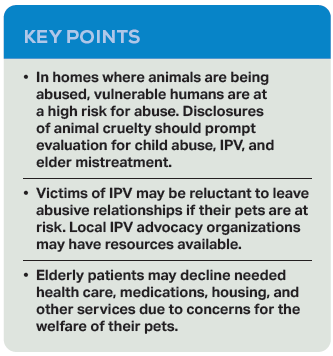
Case 1:
Explore This Issue
ACEP Now: Vol 43 – No 07 – July 2024A 5-year-old male is brought to the emergency department (ED) by his father and stepmother because they noted bruising to the child’s cheek after he returned from his biological mother’s home. The child has not told his father how the injury occurred. When asked about the bruise in the ED, he points to the plush dog he is holding and says, “My puppy got an owie here.”
Case 2:
A 32-year-old woman presents after being assaulted by her husband. Following medical care, she states that she wants to leave him but fears for the safety of her two dogs if she is not at home to protect them.
The correlation between cruelty to animals and family violence has been well established. If one type of violence is present within a family group, then other types of family violence—against children, intimate partners, the elderly, or animals—are also likely to be present. The presence of a pet in the household can serve as both a comfort to victims of abuse and a means of control.
Child abuse:
In one study, animal abuse was reported in 88 percent of homes in which physical child abuse occurred.1 Although a child might be reluctant to disclose that they are being abused, they may confide that their pet is being abused. Any disclosure of animal abuse, whether by the child or by another household member, is a red flag for child abuse and should prompt a report to the appropriate local agencies.
Violence against children and animal cruelty are linked in a cycle of violence; children who witness animal abuse are themselves more likely to become abusers of both humans and animals.2
Pets may be used as a means of control by child abusers. The gift of a pet is sometimes used to gain the trust of a child in order to “groom” them for future sexual abuse. Perpetrators may threaten the safety of pets to keep a child from disclosing abuse and to continue perpetrating the violence.
Intimate partner violence:
A history of pet abuse was found to be one of the four most significant risk factors of a person becoming a perpetrator of intimate partner violence (IPV).3 Seventy-five percent of female victims of IPV who have pets report a history of the pet being threatened or harmed by their intimate partner.4 Up to 40 percent of victims of IPV stay in abusive relationships due to fear for the safety of their pets if they leave.5 For this reason, a growing movement espouses the development of shelters for victims of IPV that can also house their pets. Many local animal shelters also provide housing and veterinary care for victims of IPV. Some states have passed legislation permitting pets to be included in protection orders. Local IPV advocacy organizations are an excellent source of information about these community resources.
Elder mistreatment:
 A similar connection exists between violence against animals and mistreatment of the elderly or other vulnerable adults. The elderly are often strongly attached to their pets, who provide companionship, stress relief, and an incentive for exercise and social interaction. This bond places the elderly person at risk for exploitation. A survey of adult protective services (APS) workers showed that more than 35 percent of clients reported that their pets had been threatened, injured, killed, or denied care by a caregiver.6 A perpetrator may use threats against an elderly person’s pets to obtain money, housing, or other items from the elderly person. Pets may also be a reason elderly people neglect themselves. Elderly patients may choose to decline health care, services, or safe housing based on concern for their pet’s welfare. Elders may prioritize their pet’s food and veterinary care over their own. Declining animal welfare may also be a warning sign of self-neglect or an early indicator of dementia.
A similar connection exists between violence against animals and mistreatment of the elderly or other vulnerable adults. The elderly are often strongly attached to their pets, who provide companionship, stress relief, and an incentive for exercise and social interaction. This bond places the elderly person at risk for exploitation. A survey of adult protective services (APS) workers showed that more than 35 percent of clients reported that their pets had been threatened, injured, killed, or denied care by a caregiver.6 A perpetrator may use threats against an elderly person’s pets to obtain money, housing, or other items from the elderly person. Pets may also be a reason elderly people neglect themselves. Elderly patients may choose to decline health care, services, or safe housing based on concern for their pet’s welfare. Elders may prioritize their pet’s food and veterinary care over their own. Declining animal welfare may also be a warning sign of self-neglect or an early indicator of dementia.
CASE RESOLUTIONS
Case 1:
You ask the child to tell you about his puppy’s injury. He explains that he has a Labrador puppy at his biological mother’s house. The puppy urinated on the floor, the mother’s boyfriend threw the puppy down the basement stairs, and the puppy has been limping. When asked about how his own bruise happened, the child is tearful and states that his mother’s boyfriend also struck him but threatened to kill the puppy if he told anyone.
You contact Child Protective Services. The child is discharged into the care of his father. The local humane officer is contacted, and the puppy is voluntarily surrendered and adopted by the child’s father and stepmother.
Case 2:
The victim advocate from the community’s IPV organization comes to the ED to speak with the patient. She informs the patient that the local human society has a safe pet program that provides housing, food, and veterinary care for victims of IPV until pet-friendly housing can be arranged. The patient elects to be discharged to the women’s shelter, and her dogs are transported to the humane society.
 Dr. Riviello is chair and professor of emergency medicine at the University of Texas Health Science Center at San Antonio.
Dr. Riviello is chair and professor of emergency medicine at the University of Texas Health Science Center at San Antonio.
 Dr. Rozzi is an emergency physician, medical director of the Forensic Examiner Team at WellSpan York Hospital in York, Pennsylvania, and secretary of ACEP’s Forensic Section.
Dr. Rozzi is an emergency physician, medical director of the Forensic Examiner Team at WellSpan York Hospital in York, Pennsylvania, and secretary of ACEP’s Forensic Section.
References
- DeViney E, Dickert J, Lockwood R. The care of pets within child abusing families. Int J Study Anim Probl.1983; 4(4):321-329.
- American Humane. Understanding the link between animal abuse and family violence. https://www.americanhumane.org/fact-sheet/understanding-the-link-between-animal-abuse-and-family-violence/ (n.d.). Accessed June 17, 2024.
- Walton-Moss BJ, Manganello J, Frye V, et al. Risk factors for intimate partner violence and associated injury among urban women. J Community Health. 2005;30(5):377-389. doi: 10.1007/s10900-005-5518-x.
- McDonald SE, Collins EA, Maternick A, et al. Intimate partner violence survivors’ reports of their children’s exposure to companion animal maltreatment: a qualitative study. J Interpers Violence. 2019;34(13): 2627-2652. doi:10.1177/0886260516689775.
- Arkow P. Animal abuse and domestic violence: intake statistics tell a sad story. Latham Letter. 1994;15(2):17.
- Humane Society of the United States, Wisconsin Department of Health and Family Services. Creating safer communities for older adults and companion animals. https://nationallinkcoalition.org/wp-content/uploads/2013/01/ElderAbuse-WisconsinManual.pdf. 2003. Accessed June 17, 2024.
Pages: 1 2 3 | Multi-Page





No Responses to “Child Abuse Cases in the Emergency Department”